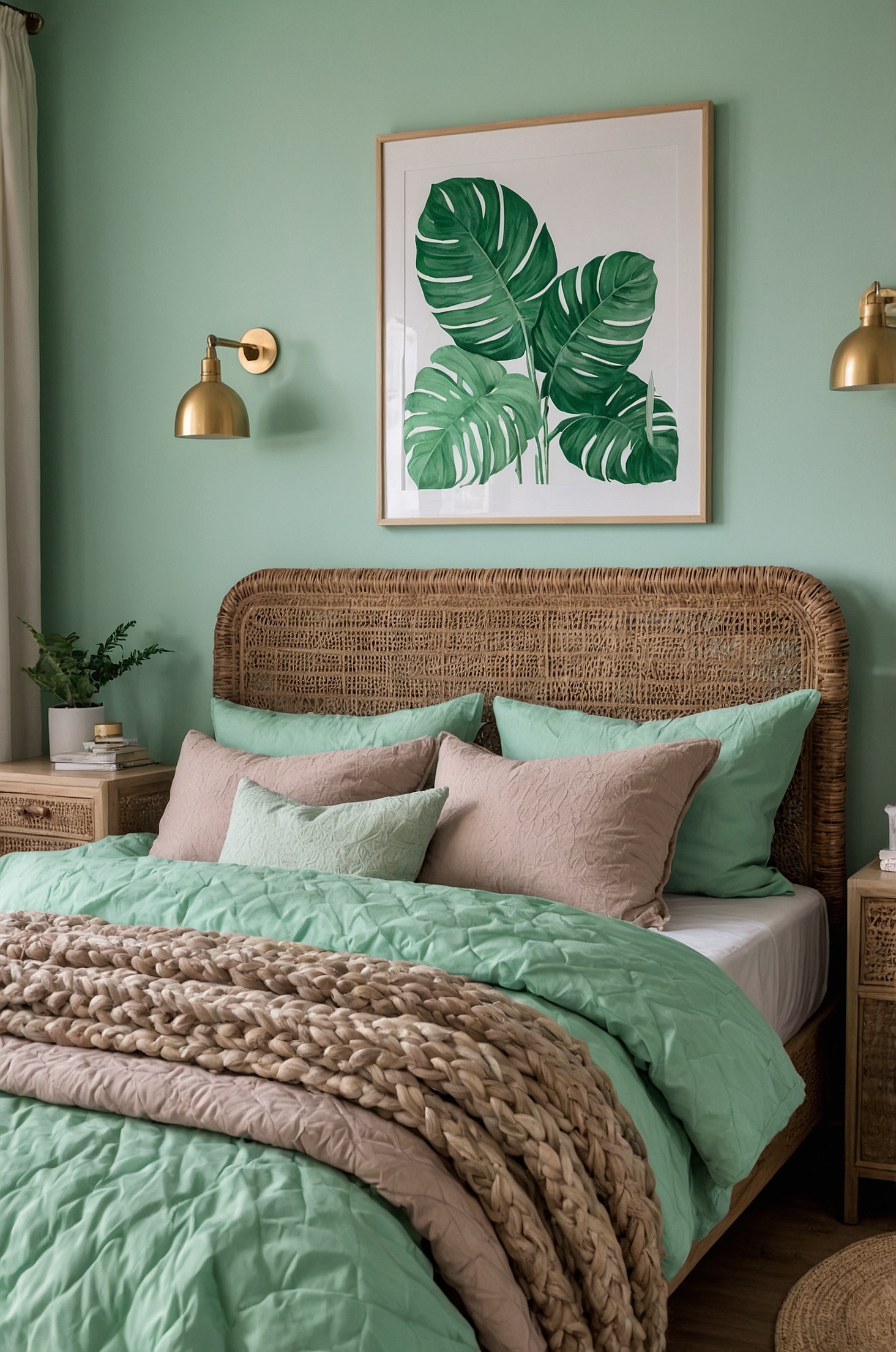I never thought a color could change my life until I painted my bedroom green.
After months of tossing and turning in my bland, lifeless bedroom, I was desperate for a change.
The beige walls and generic decor had started to affect my mood and even my sleep quality.
On a whim, I decided to introduce green into my bedroom – starting small with just a few plants and a throw pillow.
The difference was so immediate and powerful that I dove headfirst into creating a full green sanctuary.
My sleep improved, my morning anxiety decreased, and I actually looked forward to retreating to my bedroom at the end of each day.
Green isn’t just a trendy color choice – it’s nature’s neutral that brings the restorative power of the outdoors into your most personal space.
If you’re a plant lover, a color enthusiast, or simply someone seeking better rest, these TOP green bedroom ideas offer something for every style and budget.
✨Click to Get My 101 FREE Designer Room Ideas
The Magic of a Sage Green Accent Wall




That moment when you walk into a bedroom with a sage green accent wall is unforgettable – it immediately sets a tone of tranquility and sophistication.
Sage green has become the designer’s go-to for creating spaces that feel both contemporary and timeless.
This muted, grayish-green hue works like magic because it’s subtle enough to not overwhelm your space but distinctive enough to make a statement.
Painting just one wall – typically the headboard wall – creates a focal point without committing to a completely green room.
The beauty of sage green lies in its chameleon-like quality to appear different throughout the day as natural light changes.
Morning light brings out its vibrant undertones while evening light emphasizes its calming properties.
For the best results, pair your sage accent wall with crisp white trim and natural wood elements to create that perfect organic aesthetic.
Consider taking the sage green onto the ceiling for an even more dramatic and cocooning effect that designers are currently obsessed with.
If painting feels too permanent, removable wallpaper in sage green patterns offers the same impact with less commitment – perfect for renters or the design-fickle.
Textured paint techniques like lime washing or color washing add dimension to your sage wall, creating subtle variations that catch light beautifully.
The best complementary colors for sage include warm terracottas, soft pinks, and creamy whites – all colors that will make your green wall sing.
When accessorizing around your sage wall, brass or gold metals add warmth while matte black hardware creates contemporary contrast.
Professional designers recommend testing your sage green paint in multiple spots before committing, as this particular shade can read differently depending on your room’s natural light.
For the ultimate luxe look, consider a sage green paint with a subtle sheen that reflects light softly and makes your bedroom feel larger.
Create a Botanical Gallery Wall That Tells Your Story



Nothing transforms a bedroom faster than a stunning botanical gallery wall that becomes the room’s natural focal point and conversation starter.
Botanical prints bring the outdoors inside in the most sophisticated way, creating a connection to nature even in the most urban settings.
The key to a successful green botanical gallery wall is mixing both vintage and modern prints for a collected-over-time appearance that feels personal.
Your wall should include a variety of botanical subjects – from ferns and palm fronds to detailed flower illustrations and abstract leaf patterns.
Creating a cohesive look despite different art styles comes down to consistent framing – opt for thin gold frames or natural wood for a pulled-together aesthetic.
The placement of your gallery needs to follow a loose pattern – not too symmetrical (which can feel stuffy) but not completely random (which can feel chaotic).
Start with a central, larger piece as your anchor, then build outward with smaller complementary prints that create visual balance.
Vintage botanical illustrations from old science textbooks or horticultural guides can be found affordably online and add authentic character to your collection.
For a modern twist, include black and white botanical photographs or abstract green watercolors among the more traditional illustrations.
The green tones in your gallery wall subtly influence the room’s color palette, allowing you to pull those same greens into your bedding and accessories.
Consider adding three-dimensional elements like preserved moss frames or shadow boxes with pressed leaves to add texture and depth to your wall.
Your gallery wall should be positioned where you’ll see it most – perhaps opposite your bed or above a dresser where you can appreciate the details daily.
Install proper picture lighting above your botanical gallery to highlight the artwork and create a warm glow in the evening hours.
The best part about this decor idea is that it can grow over time – adding new botanical prints as you discover them makes your space feel evolutionary rather than static.
The Luxurious Emerald Green Velvet Headboard Statement
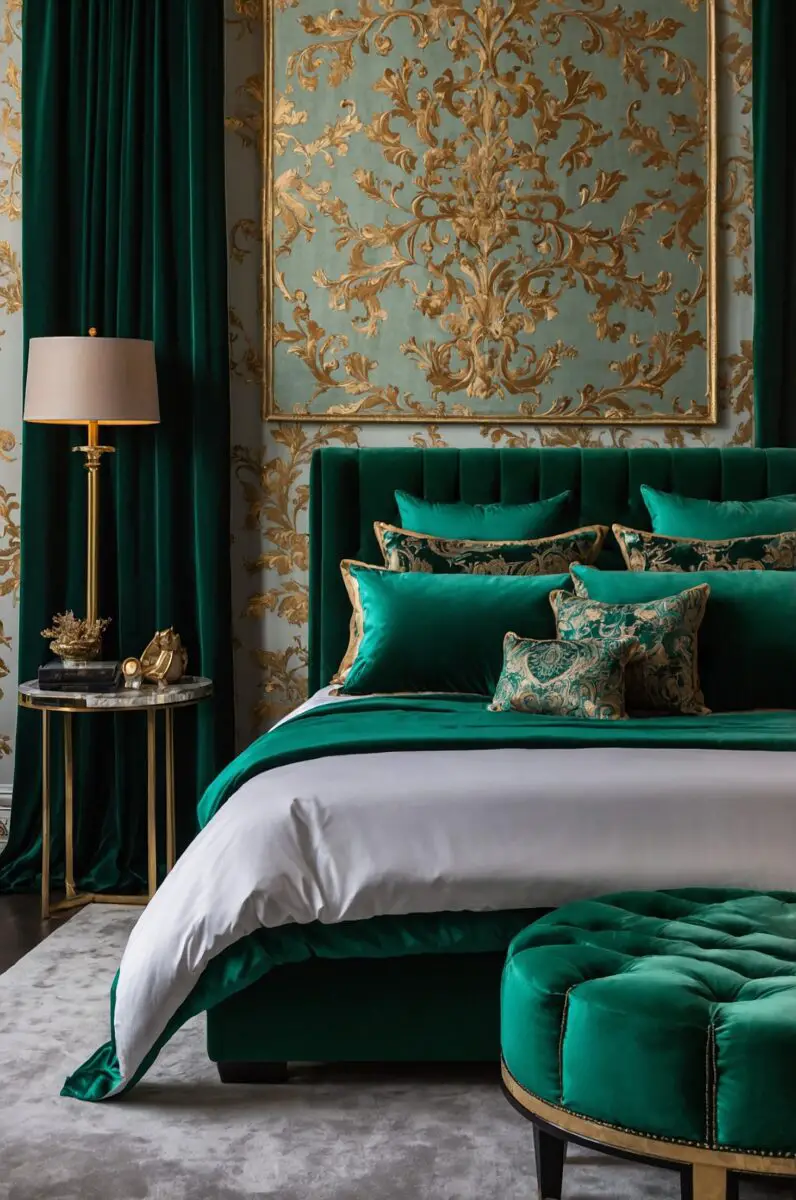

Walking into a bedroom with an emerald green velvet headboard changes the energy instantly – it’s like a visual declaration of confidence and style.
Velvet as a material captures and plays with light in a way no other fabric can, creating a dimension of luxury that transforms ordinary bedrooms into boutique hotel experiences.
The rich jewel tone of emerald green creates a perfect backdrop for both neutral linens and bold pattern mixing, making it surprisingly versatile despite its strong personality.
Height matters with an emerald headboard – the taller the better, with designer-approved proportions reaching at least 24 inches above your mattress for maximum impact.
The tactile quality of velvet invites touch, making your bed feel like a cozy retreat rather than just a place to sleep.
When paired with white bedding, an emerald headboard creates a crisp, clean contrast that feels both modern and classic simultaneously.
For a more eclectic vibe, mix your emerald headboard with patterned sheets featuring small-scale prints in complementary colors like blush, gold, or navy.
The secret to making this look work is balancing the boldness of the headboard with simpler elements elsewhere in the room – let the emerald be the star.
Buttons, channel tufting, or vertical ribbing add architectural interest to your headboard while showcasing velvet’s natural ability to create depth through shadow.
Lighting plays a crucial role in maximizing the impact of emerald velvet – position bedside sconces or lamps to cast a gentle glow that highlights the fabric’s rich texture.
Designers recommend flanking your emerald headboard with light-colored nightstands to create breathing room around the strong color statement.
For added drama, consider extending the emerald velvet to create a fully upholstered bed frame that cocoons you in luxury.
To prevent the look from feeling too heavy, balance the substantial headboard with plenty of light, reflective surfaces elsewhere in the room – think mirrors, glass lamps, or metallic accents.
The beauty of emerald green is its timelessness – unlike trendy colors that quickly date, this jewel tone has remained desirable from Victorian parlors to contemporary penthouses.
Transform Your Ceiling into a Hanging Plant Paradise
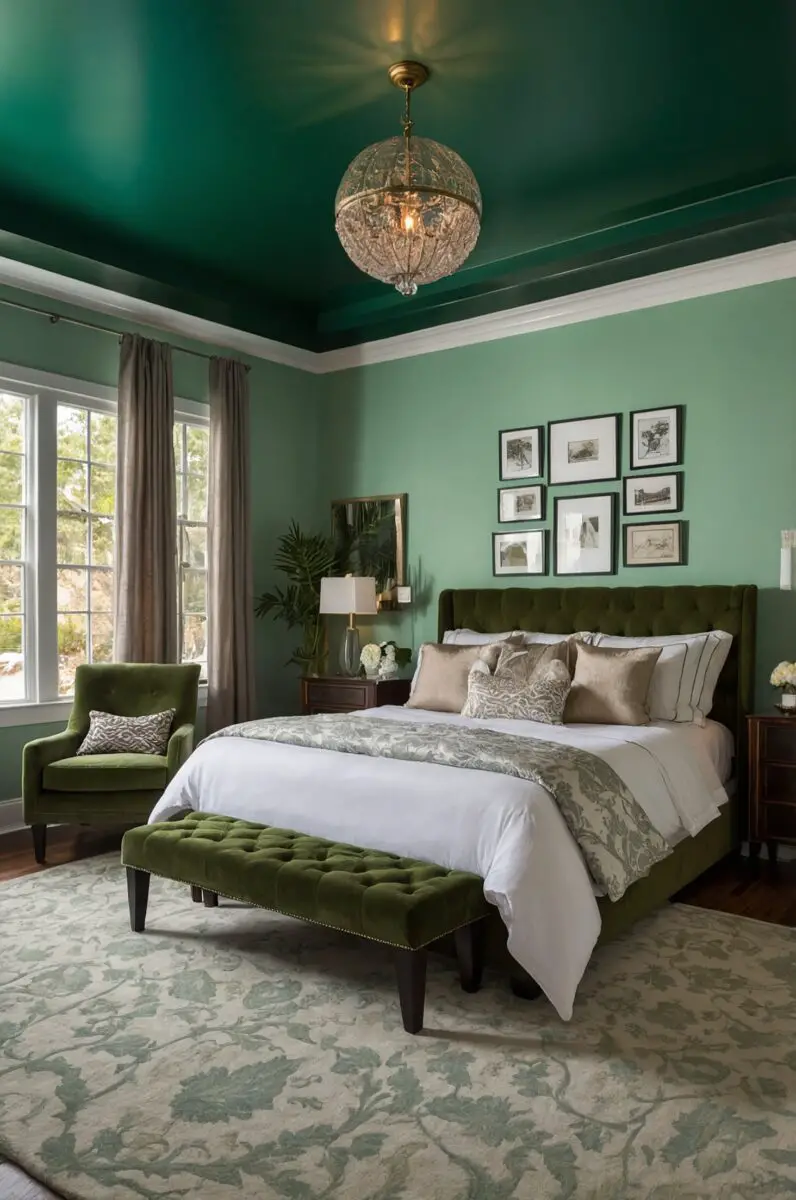


Imagine waking up to a canopy of lush greenery suspended above you, filtering morning light and creating dancing shadows across your bedroom.
The ceiling is your most underutilized decorating space, and transforming it into a hanging garden creates a three-dimensional green experience that conventional decor can’t match.
Macramé plant hangers in various lengths create visual rhythm and allow you to position plants at different heights for a waterfall effect of greenery.
The gentle movement of plants with air circulation adds a subtle kinetic element to your bedroom – like bringing a gentle forest breeze indoors.
Select plants with trailing habits like pothos, spider plants, or string of pearls for maximum impact as they create living curtains of green that frame your sleeping space.
Beyond the aesthetic benefits, hanging plants actually improve your bedroom’s air quality by removing toxins and increasing humidity – perfect for better sleep quality.
The secret to a successful hanging garden is creating a support system that’s both secure and invisible – consider installing ceiling hooks into studs or using tension rods between walls.
Vary your planters between ceramic, woven, and metal options to create textural contrast that catches light differently throughout the day.
Position your hanging plants strategically – cluster them in corners, suspend them at windows where they’ll thrive, or create a green divider in an open-concept bedroom.
For renters, command hooks rated for appropriate weight can support smaller plants without damaging ceilings, making this a surprisingly apartment-friendly green option.
Consider the maintenance factor by installing a small pulley system for larger plants, allowing you to lower them easily for watering without climbing on furniture.
The color palette of your plants matters – mix different shades of green from deep emerald to bright chartreuse for a rich, layered look.
Add unexpected elements like hanging air plants in glass terrariums or small grow lights disguised as decorative pendants for plants in darker corners.
For the ultimate luxury, include a few flowering hanging plants like orchids or hoyas that will periodically reward you with blooms right above your bed.
✨Click to Get My 101 FREE Designer Room Ideas
Forest-Inspired Bedding That Transforms Your Sleep Experience
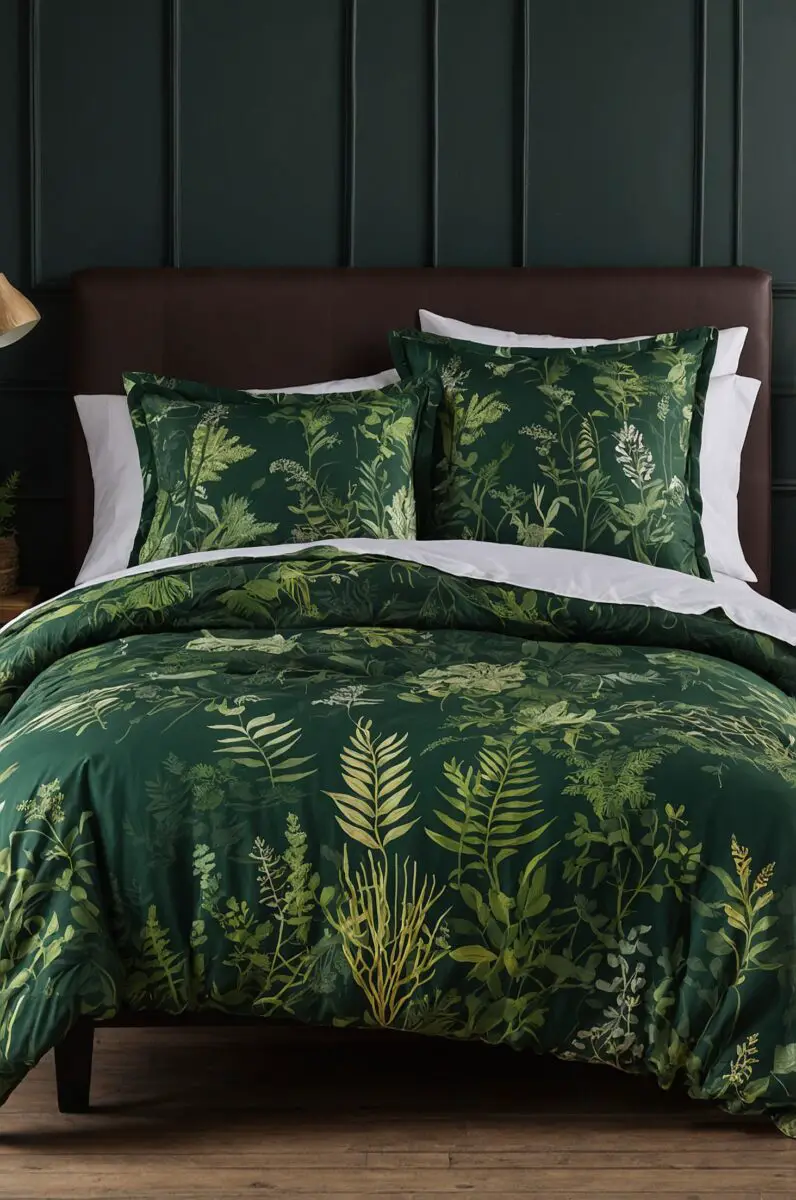

The first thing you touch when climbing into bed should transport you instantly to a peaceful forest floor, surrounded by the calming greens of nature.
Forest-inspired bedding goes beyond simple green sheets, incorporating subtle patterns of ferns, leaves, or abstract botanical motifs that add depth without overwhelming.
The key to sophisticated green bedding lies in layering different shades and textures – from sage cotton sheets to emerald velvet pillows and moss-colored knit throws.
Thread count matters when selecting green bedding – opt for at least 300-thread count cotton that will hold rich green dyes while feeling luxurious against your skin.
Unlike loud patterns that quickly tire the eye, botanical patterns in monochromatic green tones create visual interest that remains restful and conducive to sleep.
The best forest-inspired bedding incorporates texture through techniques like jacquard weaving, subtle embossing, or tonal embroidery that catches light as you move through your space.
Consider the psychology of your green bedding choices – cooler blue-greens like eucalyptus promote calm while warmer yellow-greens like olive create coziness.
For maximum impact, extend your forest theme to your bed skirt or consider a green upholstered bed frame that creates a fully immersive natural experience.
Mixing solid green pieces with patterned ones creates a sophisticated look – perhaps solid sheets with a duvet cover featuring subtle leaf impressions.
Add unexpected touches like velvet ribbon trim on pillowcases or hand-embroidered leaf details on throw pillows for custom details that elevate your bedding.
For a truly luxurious forest bed, layer a minimum of five pillows in varying green shades, sizes, and textures – creating an inviting landscape that beckons you to rest.
Don’t forget practical considerations – darker green bedding hides stains better but shows lint, while lighter greens show dirt but disguise pet hair.
The trend of performance fabrics has reached bedding, offering green options that resist stains, wick moisture, and maintain their color despite regular washing.
Seasonal switching keeps your forest theme fresh – lighter, brighter greens in spring/summer and deeper, mossier tones for fall/winter creates a bedroom that evolves with nature’s cycles.
Vintage Green Glass Collectibles for Character and Depth




The moment light hits a collection of vintage green glass bottles on a windowsill, casting emerald shadows across your bedroom, you’ll understand their magnetic appeal.
Vintage green glass pieces – from Depression glass to mid-century vases – add a layer of history and soul that new decor items simply cannot replicate.
The varying tones of vintage green glass create a fascinating color study – from the pale jade of some medicine bottles to the deep emerald of old seltzer bottles.
What makes green glass particularly special is how it interacts with light throughout the day, acting as both color source and light filter in your bedroom.
Starting a collection is surprisingly affordable – thrift stores, flea markets, and estate sales often have green glass pieces for just a few dollars each.
The trick to a sophisticated display rather than clutter is grouping similar items together – all bottles in one collection, all drinking vessels in another.
Height variation creates visual interest – mix taller decanters with squat jars and medium-height candlesticks for a dynamic arrangement.
Position your green glass where natural light will hit it – on windowsills, on mirrored trays, or on floating shelves where morning sun creates a green light show.
Beyond decorative value, vintage green glass pieces can serve practical functions – use apothecary jars for cotton balls, carafes for bedside water, or candle holders for ambient lighting.
The subtle green tint these pieces add to your bedroom creates a cohesive color story without the commitment of green paint or large furniture.
For maximum impact, collect glass in similar color families – either all deep emerald pieces or all pale sea-glass tones rather than mixing dramatically different greens.
Historical context adds conversation value – Depression glass has different patterns and histories than 1960s Blenko glass, giving your decor intellectual depth.
Consider the negative space around your glass collection as important as the pieces themselves – allow breathing room between items for light to play through them.
Small LED puck lights positioned behind glass collections create dramatic evening displays, transforming your vintage finds into modern light sculptures after dark.
Dark Green Built-In Shelving: The New Neutral for Storage

Walking into a bedroom with dark green built-in shelving feels like discovering a secret library in an old English country house – instantly sophisticated and timeless.
Unlike white or wood shelving that merely fades into the background, dark green built-ins become architectural features that anchor your space with purpose and style.
The psychology behind dark green is fascinating – it creates a sense of permanence and stability while simultaneously connecting to nature in a primal, comforting way.
Forest green, hunter green, or deep olive tones create the perfect backdrop for displaying both colorful objects and neutral items – making everything you own look more intentional.
The magic happens in the contrast between the dark shelving and what you place on it – white-spined books, brass objects, and cream ceramics practically glow against green.
Unlike trendy colors that quickly date, dark green has historical precedent in libraries and studies dating back centuries, giving your bedroom an educated, collected feel.
Consider extending your green built-ins around your bed to create a frame that cocoons your sleeping area while providing practical storage for books and bedside necessities.
The vertical lines of bookshelves naturally draw the eye upward, making your ceiling appear higher and your bedroom more spacious despite the darker color.
For rental-friendly versions of this look, seek out freestanding bookcases that can be painted in removable chalk paint or covered with peel-and-stick wallpaper in deep green tones.
The texture of your green shelving matters – consider adding beadboard backing, fluted details, or glass-front sections to create visual interest beyond just the color.
Lighting your green shelves properly transforms them from daytime storage to evening ambiance – install small LED strips under shelves for a museum-quality display effect.
Hardware selection dramatically affects the overall look – antique brass pulls create a traditional library feel while matte black hardware pushes the look toward contemporary.
The inner backs of shelves offer opportunities for surprise – consider wallpapering just these sections with botanical prints or adding mirror panels to reflect light.
Open shelving creates breathing room, but including some cabinet sections with solid green doors allows you to hide less attractive but necessary bedroom items.
Green Marble Elements: Luxurious Natural Accents



The moment you introduce green marble into your bedroom, the entire energy shifts toward sophisticated luxury that feels both contemporary and completely timeless.
Unlike the common white Carrara or black marble varieties, green marble varieties like Verde Alpi or Guatemala Green carry nature’s most restful color in fascinating, unrepeatable patterns.
The depth and variation in genuine green marble create natural artwork – no two pieces identical, with white veins, black specks, and varying green tones telling geological stories in your bedroom.
Small doses of green marble make massive impact – consider bedside table tops, drawer fronts, or even just decorative trays and bookends for an accessible entry point.
The cool, smooth surface of marble provides textural contrast in bedrooms otherwise filled with soft textiles, creating balance between comfort and sophistication.
For the ultimate luxury statement, a green marble headboard wall creates a natural focal point that no painted surface could ever match in depth and character.
Green marble pairs beautifully with both warm metals like brass and cool metals like chrome, making it adaptable to your existing hardware and lighting fixtures.
The weight and solidity of marble pieces create grounding elements in your bedroom design – a counterpoint to lightweight textiles and more transient decorative elements.
For those concerned about sustainability or budget, new porcelain tiles and laminates perfectly mimic green marble’s appearance while being more affordable and environmentally friendly.
Position green marble pieces where they’ll catch light – the natural minerals within the stone create subtle sparkle and dimension as lighting changes throughout the day.
Unlike trendy materials that quickly date, marble has been prized since ancient Roman times, making it one of the few materials guaranteed to retain both value and aesthetic appeal.
The natural cooling properties of marble make it particularly pleasant in warmer climates or for hot sleepers – green marble bedside tables feel refreshing to the touch on summer nights.
For unexpected applications, consider green marble switch plates, picture frames, or even a single marble shelf floating on an otherwise simple wall.
Caring for your green marble investments is simple but specific – use only pH-neutral cleaners and seal annually to protect against staining and etching.
✨Click to Get My 101 FREE Designer Room Ideas
Teal and Gold Luxury: The Regal Green Bedroom Palette

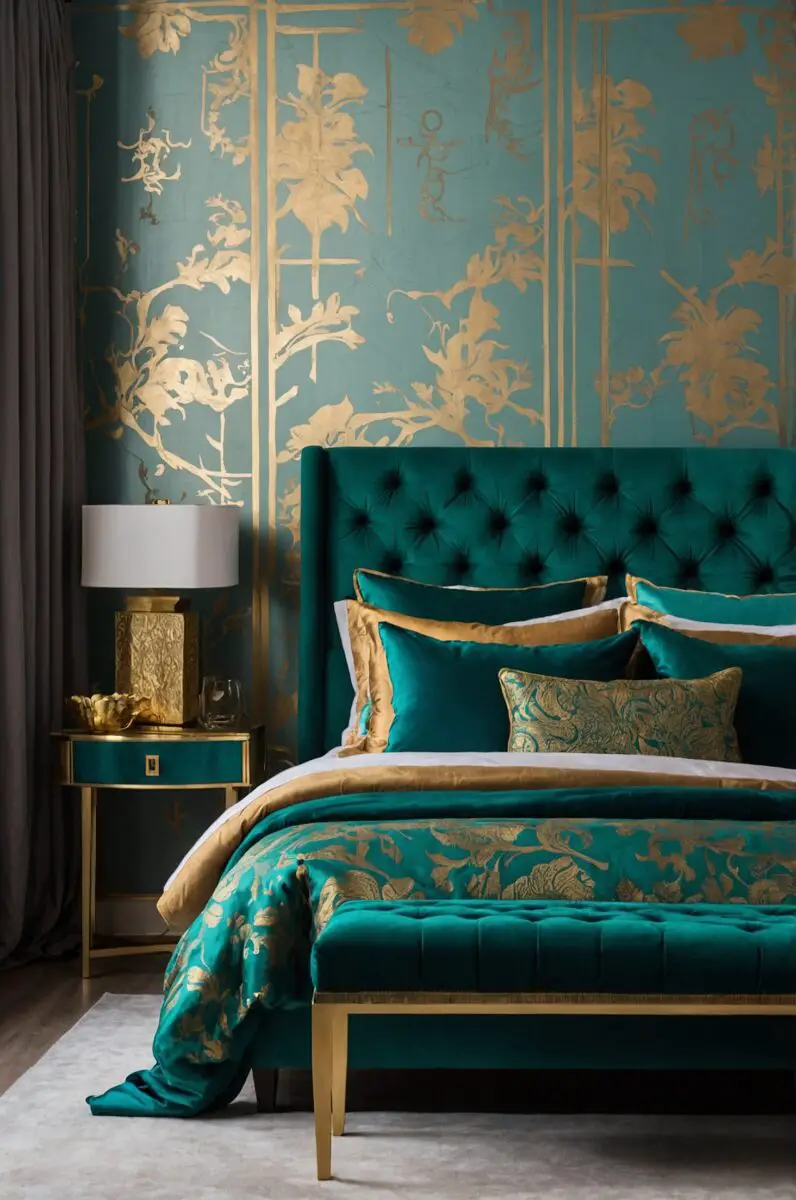
The first time you see a teal and gold bedroom, you understand immediately why this color combination has adorned palaces and luxury hotels for centuries.
Teal – that perfect balance between blue and green – creates a sophisticated backdrop that feels both cozy and expansive simultaneously.
Unlike true greens that direct us toward thoughts of nature, teal evokes water and sky while maintaining the calming properties that make green ideal for bedrooms.
Gold accents against teal create electric visual contrast that draws the eye without overwhelming it – the perfect balance of stimulation and relaxation.
The reflective properties of gold metallics bounce light around a teal room, preventing the deeper color from absorbing too much light or feeling cave-like.
Start your teal and gold palette with walls – either commit fully to teal paint or use it on a single accent wall behind your bed for maximum impact with minimum risk.
Layer in gold through lighting fixtures first – a statement ceiling fixture with warm gold tones establishes the pairing as intentional rather than accidental.
Fabric choices matter tremendously in this palette – velvet in teal absorbs light while silk catches and reflects it, creating dimensional depth through textile selection alone.
For pattern mixing within this color story, incorporate small-scale geometric patterns in gold on teal backgrounds through pillows or throws.
The secret to keeping teal and gold from feeling overwhelming is incorporating plenty of white space through crisp white bedding or light-colored flooring.
Consider the undertones in your teal carefully – greener teals pair best with warm antique golds while bluer teals complement brighter yellow-toned golds.
Add black as a grounding neutral that gives the eye resting places amid the rich color pairing – black picture frames, lamp bases, or furniture legs create necessary anchors.
For maximum luxury, incorporate actual gold leaf details on furniture pieces or mirror frames rather than just gold-toned metals – the subtle difference is immediately apparent.
The psychology behind this color pairing explains its enduring appeal – teal promotes restful sleep while gold triggers associations with success and achievement.
Mint Green and Rattan: The Fresh Modern Organic Bedroom


Walking into a mint green and rattan bedroom feels like stepping into a modern tropical resort where freshness meets natural texture in perfect harmony.
Mint green – that perfect pale hue between seafoam and sage – creates an instant mood lift while remaining subtle enough to surround yourself with daily.
The beauty of mint is its chameleon quality – in morning light it reads slightly blue, by afternoon it appears more green, and by lamplight it takes on a soft, almost neutral quality.
Pairing mint with rattan creates magical contrast – the smooth, cool mint surfaces making the warm, textural rattan elements even more pronounced and interesting.
Rattan’s natural variation in color – from pale blonde to warm honey tones – creates subtle dimension against mint backgrounds that flat-colored furniture cannot achieve.
Begin implementing this palette with larger statements – perhaps mint walls with a substantial rattan bed frame or headboard as your room’s anchor.
The woven patterns in rattan naturally draw the eye, creating visual interest through shadow and light that complements mint’s more subtle, even coverage.
For a contemporary take on this pairing, look for rattan pieces with modern silhouettes – clean-lined nightstands or geometric pendant lights that avoid any “grandma’s sunroom” associations.
Layer in natural linens in complementary neutral tones – oatmeal, ivory, or pale taupe bedding creates breathing space between your mint and rattan elements.
The sustainability story of this pairing adds another dimension of appeal – rattan is rapidly renewable while many mint paints now come in low-VOC, eco-friendly formulations.
Consider the negative space in rattan pieces as important as the material itself – the open weaves create fascinating shadow patterns against mint walls when properly lit.
Temperature balance makes this pairing work on a psychological level – cool mint prevents the warm rattan from feeling too tropical or seasonal.
For unexpected applications, consider mint green ceiling paint paired with a rattan fan, reversing the typical placement of these elements for dramatic effect.
Incorporate subtle pattern through mint green botanical prints in simple frames that reference the natural origins of your rattan pieces.
Olive Green Upholstered Furniture: Timeless Sophistication


The moment you add an olive green upholstered piece to your bedroom, you tap into both ancient and contemporary design wisdom about creating spaces that feel eternally relevant.
Olive green carries unique versatility – it’s technically a green but functions as a sophisticated neutral that pairs with virtually every other color in your design arsenal.
The depth and complexity in olive tones come from their balanced position between yellow and black undertones, creating a color that reads differently throughout the changing light of day.
Unlike trendy greens that cycle in and out of fashion, olive has remained consistently desirable from Renaissance paintings to modern boutique hotels.
The right olive upholstered piece – whether a tufted bench at the foot of your bed or a reading chair in the corner – adds instant gravitas and intentionality to your bedroom.
Fabric selection dramatically affects how your olive green reads – linen creates casual sophistication, velvet adds luxury, and leather develops beautiful patina over time.
Position your olive upholstered pieces where they’ll create conversation with other elements – perhaps across from wooden furniture to highlight the natural connection between these materials.
The psychological effect of olive green stems from its abundant presence in nature – it triggers subconscious associations with established trees and perennial plants rather than fleeting seasonal growth.
For maximum longevity, select simple, classic silhouettes for your olive upholstery – the color itself carries enough character to make even basic forms feel special.
Pair olive upholstery with crisp whites for modern contrast, warm woods for traditional harmony, or black accents for contemporary edge – its chameleon quality works with all approaches.
Consider the scale of your olive pieces carefully – a single substantial piece like an olive headboard creates more impact than multiple small olive accessories scattered throughout.
The natural companion metals to olive upholstery are unlacquered brass and bronze, which share its warmth and tendency to develop character over time.
For pattern mixing, olive works beautifully with both traditional patterns like damask or toile and modern geometric prints – the key is maintaining olive as the dominant note.
The maintenance advantage of olive upholstery is significant – this middle-tone color hides daily wear far better than lighter fabrics while remaining less light-absorbing than darker options.
Tropical Green Wallpaper: Your Personal Paradise Retreat


The transformation that happens when you install tropical green wallpaper in your bedroom is nothing short of magical – instantly transporting you from ordinary space to personal sanctuary.
Unlike the subtlety of painted walls, tropical wallpaper creates an immersive experience with depth, movement, and narrative that flat color simply cannot achieve.
The psychology behind surrounding yourself with lush green patterns taps into our biophilic needs – our innate desire to connect with natural patterns even when we sleep in urban environments.
Modern tropical wallpapers have evolved far beyond your grandmother’s busy florals – today’s designs range from photorealistic jungle scenes to sophisticated abstract interpretations of tropical foliage.
The dimensional quality of well-designed tropical papers creates the illusion of expanded space – the depicted foliage suggesting depth that extends beyond your actual walls.
For maximum impact with minimum commitment, install tropical wallpaper on just your headboard wall, creating a focal point that frames your bed like a portal to a lush escape.
The latest wallpaper technology includes peel-and-stick options that make this transformation rental-friendly and removable when you’re ready for a change.
Pattern scale matters tremendously – larger patterns with more negative space create drama without overwhelming, while smaller, denser patterns create more textural, less figurative impact.
Color variation within your tropical pattern creates visual richness – look for designs incorporating multiple green tones from chartreuse to emerald rather than flat, single-shade patterns.
The secret to sophisticated tropical wallpaper is finding designs with properly rendered botanical elements – papers based on actual plant species rather than generic “jungle” motifs.
Balance your statement wallpaper with simpler, solid-colored furniture that allows the pattern to take center stage without competition.
Consider the directionality of your tropical pattern – vertical elements like bamboo or palm trunks draw the eye upward and make ceilings appear higher.
Lighting your tropical wallpaper properly transforms it from day to night – consider wall sconces that cast light across the surface to highlight the dimensional quality after dark.
For unexpected applications, extend your tropical paper onto the ceiling or inside closets for surprise moments that maintain the immersive quality of your green retreat.
✨Click to Get My 101 FREE Designer Room Ideas
Biophilic Green Design: The Science-Backed Bedroom


The moment you implement true biophilic green design in your bedroom, you’re not just decorating – you’re fundamentally changing how your space affects your physical and mental wellbeing.
Biophilic design – the practice of connecting humans meaningfully to nature indoors – uses green not just as a color choice but as part of a comprehensive approach to natural connection.
The science behind green biophilic bedrooms is compelling – studies show improved sleep quality, reduced stress markers, and enhanced cognitive restoration in nature-connected spaces.
Unlike trend-based design approaches, biophilic principles are rooted in evolutionary psychology – addressing our innate need for natural connections that dates back thousands of years.
Start your biophilic bedroom by maximizing natural light – position your bed to view outdoors, remove heavy window coverings, and use light-reflecting surfaces to amplify available sunlight.
Incorporate direct nature through carefully selected indoor plants – choosing varieties like snake plants or peace lilies that release oxygen at night specifically for bedroom environments.
The material selection in biophilic bedrooms prioritizes natural, minimally processed elements – opting for solid wood over veneer, wool over polyester, and stone over plastic.
Create multi-sensory connections to nature through sound (water features or nature recordings), touch (varied natural textures), and scent (essential oils from plants).
The color strategy extends beyond simple green paint to incorporate the full spectrum of nature’s greens – from yellow-greens that evoke early spring to blue-greens that reference water.
Pattern incorporation follows natural principles – using design elements that feature the Fibonacci sequence, fractal patterns, or organic shapes found in nature.
Consider the circadian rhythm support that green elements provide – cooler green lighting in evening hours signals your brain to prepare for sleep more effectively than blue-toned lights.
Integrate natural airflow patterns by positioning plants and furniture to allow air circulation that mimics outdoor environments rather than stagnant indoor air.
The complexity and order balance in well-designed biophilic bedrooms creates the perfect level of stimulation – interesting enough to engage your mind but ordered enough to promote relaxation.
For rentals or limited-commitment situations, portable biophilic elements like free-standing plant walls, natural fiber rugs, or botanical projections create nature connections without permanent changes.

